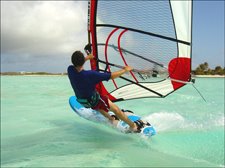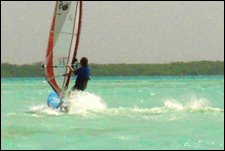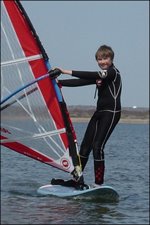Kiteboard Construction Notes
First Board- 152 x 44, Plywood, "Clo se to the Edge" 1/2" Baltic birch, planed down on edges & tips (on top only), to reduce weight, increase flex, and create thinner rails. I used a hand held power plane to rough it out, then small belt sander to make smooth. Covered the top with putty to fill grain and voids and sanded with random orbit sander. NOTE- next time sand se to the Edge" 1/2" Baltic birch, planed down on edges & tips (on top only), to reduce weight, increase flex, and create thinner rails. I used a hand held power plane to rough it out, then small belt sander to make smooth. Covered the top with putty to fill grain and voids and sanded with random orbit sander. NOTE- next time sand  more to thin rails to 1/8" or 3/16" all around for better grip in the water, less weight and added flex. more to thin rails to 1/8" or 3/16" all around for better grip in the water, less weight and added flex. Cost of wood- $25, (half of a 60" x60" sheet). I taped off the edge and sprayed several coats of flat waterborne paint on top, left bottom unpainted, applied graphics, brushed on 1 coat of epoxy on top and 2 on bottom. NOTE- next time seal bottom with clear spray on finish and topcoat with 1 coat of epoxy to save weight, (1 coat of epoxy over bare wood isn't smooth enough). Inserts for handle & footstraps- brass, from McMaster & Carr. Holes for fins drilled big, filled with epoxy, redrilled. Fins- $40. $10/ea from Fins4Sale.com- New 10-24t two hole mount Kiteboard Fin - 2.0 Flathead Gloss |
Handle- mahogany, pattern drawn on with magic marker, cut on band saw, sanded on stationary belt sander.
Pads, stick-on, $20 for pair. Straps- Dakine windsurfing straps from an old board.
Graphics- "Close to the Edge", digital file from Internet printed on water slide decal paper. Rolling Stones mouth- sticker. I tried rice paper made for surfboard graphics, looks good but it requires about 3 coats of epoxy to cover it. Note- next time, for clear decal, use clear matt label paper, put a layer of sealer or epoxy down under the decal.
Epoxy- 8 ounces per coat, clear boatbuilding epoxy, $10.
Update- How did it ride? It was O.K. in flat water/ light winds. It really went upwind well! Problems- no flex, heavy, no rocker, wide tips. Symptoms- I had to use a lot of back foot pressure to keep the tip up in any chop at all since it had 0 rocker and wide tips. I got a lot of thigh burn using this board, same muscles as skiing. It splashed in my face a lot. Retired after about 1 year.
Second Board- 132
 x 41.5, Plywood, "Storm Chaser" 2 layers of 1/4" birch plywood glued up with 1/2" of rocker on each end, planed down o
x 41.5, Plywood, "Storm Chaser" 2 layers of 1/4" birch plywood glued up with 1/2" of rocker on each end, planed down o n edges and tips (on top only). Cost of wood-$0, I used scrap from the shop.
n edges and tips (on top only). Cost of wood-$0, I used scrap from the shop. This board was lighter than my first and had some flex but otherwise had many of the same problems as my first board, not enough rocker, tiring on legs, spray in the face. Retired after 1 year.
Mad Cow- 180 x 60, Pink foam,
 fiberglass, plywood bottom, twin tip surfboard.
fiberglass, plywood bottom, twin tip surfboard.This is the ultimate light wind cruiser. It works down to 10 MPH with 17 meter Zephyre, or 8 MPH with Flysurfer 15 meter Speed 2. Very light weight board but extremely delicate, not enough layers of fiberglass cloth on top (1 full layer with second layer under footpads and handle). Plenty of rocker. Fun sometimes. Pink insulation foam is cheap but outgasses when it heats up. This causes delamination bubbles on the board if left face up in sun on beach. Still in use until it breaks.
Plywood skimboard

This board has rocker and concave. I'm still experimenting with it, want to try it with small fins for better upwind grip. It has almost no flotation, which makes waterstarts hard. I think that's why most kite skimboards are made out of foam.
Link for Wooden Surfboard, made from scrap, with hollow chambers-




















web225H.jpg)

2 comments:
Thank you for the notes, i really appreciate that you are sharing them with all your readers.
Robert
Robert, Thanks for the comments on my board! The 2 things I hear when people see it in person-"wow, it looks great!" "Wow, it weighs a ton!" The jury is still out on how well it rides.
Post a Comment